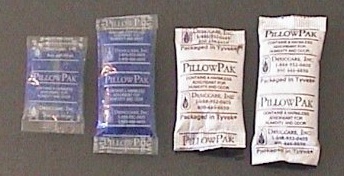PWTEC Introduction
![]() Distribution
Distribution ![]() News
News ![]() Notes & Interesting Articles
Notes & Interesting Articles ![]()
![]() Products Index
Products Index


|
PARTICLE WAVE TECHNOLOGIES - DDCAP DESICCANT CAP
-
among the most important standard accessory for the well being of a telescope
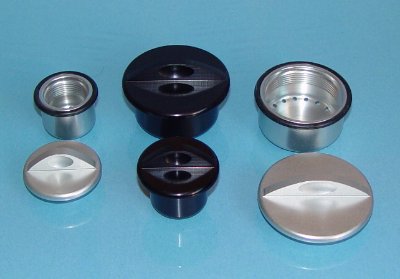 Company Seven customers know Particle Wave Technologies (PWTEC) for their Monolith and Pinnacle models of field tripods, these are our the most sophisticated and elegant products of their class. But the PWTEC company actually first became known to us for their innovative 'DDCAP' covers for the telescope focuser. These devices incorporate a reservoir filled with small packets of desiccant (a hygroscopic or water absorbing substance) to absorb humidity that normally is in the air within a telescope optical tube. By keeping the interior of a telescope dry this promotes good health of the instrument and reduces the probability of optics interior fogging or developing water drop marks.
Company Seven customers know Particle Wave Technologies (PWTEC) for their Monolith and Pinnacle models of field tripods, these are our the most sophisticated and elegant products of their class. But the PWTEC company actually first became known to us for their innovative 'DDCAP' covers for the telescope focuser. These devices incorporate a reservoir filled with small packets of desiccant (a hygroscopic or water absorbing substance) to absorb humidity that normally is in the air within a telescope optical tube. By keeping the interior of a telescope dry this promotes good health of the instrument and reduces the probability of optics interior fogging or developing water drop marks.
Right: DDCAP finger grip top models. Left 1.25 in clear (natural aluminum), closed DDCAP 1.25 and 2 in black, and open DDCAP 2 in clear.
The DDCAP is a precision machined container for desiccant made to fit onto the focuser of a telescope focuser or onto the port of sensitive accessories. Each DDCAP consists of a desiccant reservoir with thread-on cover. Each new DDCAP is provided with ten pair of desiccant packs. To load desiccant simply unscrew the cover to access the open port the slip in the packs. Thread the cover into place and slip the DDCAP onto a focuser with the chamber protruding into the telescope focuser drawtube. Secure DDCAP by the thumb screw or the compression ring on the telescope or accessory, just like an eyepiece or a diagonal. The design prevents DDCAP from falling into the telescope
The reservoir of DDCAP has precision drilled ports that permit the draw of humidity into the desiccant within the container. A rubber gasket helps to form a better seal where the DDCAP meets the focuser, and this acts as a shock absorber when in transit too. A vinyl cover and a set of Velcro disks are included with each DDCAP. When the DDCAP is not being used, such as when removed from the telescope or diagonal, then simply slide the vinyl cover over the DDCAP to seal its ports from outside air and moisture. The Velcro disks can be used to attach the vinyl cover to the telescope or onto other equipment for easy access and to prevent misplacing the DDCAP and the plug in the dark.
The desiccant are packs of indicating silica gel (SG) and packs of molecular sieve (MS). MS is a non-hazardous high tech desiccant with higher capacity for water adsorption and a higher adsorption rate too than either silica gel or clay at very low to moderate humidity levels. The MS and SG are provided in small pouches so no particles or dust are released into the telescope optical tube. The pouch arrangement makes it easy to change the desiccant.
Most DDCAP are formed from solid 6061 T-6 aluminum stock by computer controlled milling machines. An even more beautiful version of the DDCAP made of heavy brass is available. We invite you to visit Company Seven to see these items among the most unusual collection of telescopes in the Americas.
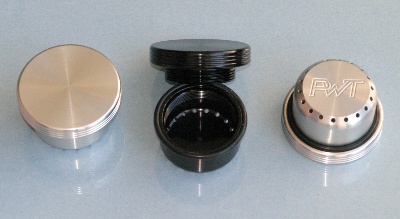
Above: Flat Top Models. top view, in black open, and bottom view showing ports and gasket.
Why DDCAP? Keeping the interior of a telescope and its costly accessories clean and dry promotes good health of the instrument. The DDCAP protects the telescope by keeping dust and dirt from passing through its seal, and DDCAP reduces the probability of optical surfaces in the interior of the assembly fogging or developing water droplet stains. You can solve these problems and do it in style and for all your telescopes and sensitive accessories.
In Company Seven's extensive experience in making, selling and servicing consumer and industrial telescopes, we have observed the two dominant mechanisms by which telescopes are destroyed: 1. impact and 2. fungus. The first is obvious, something struck the telescope or the telescope was dropped. But the latter is far more insidious, taking time over weeks or months to do its damage; and often once entrenched then it is not possible to repair the optics. Fungus can occur anywhere an item is left stored in a moderate temperature humid climate, this is most commonly thought of as being in a Panama or Hawaii tropical climate; but we have seen telescopes destroyed sitting in a West Virginia basement too. If fungus is allowed to proser, the it will grow on surfaces including the optics, it will release enzymes that can not only dissolve coatings but can actually etch glass. If the glass is etched then it is most likely not cost effective to regrind, polish and figure the optics; we would simply replace the optic(s) component after matching or as a complete set (corrector lens and primary mirror). Desiccant absorbs moisture and reduces the chance of fungus developing within the optical tube.
It was only in 2005 after Astro-Physics company decided not only to recommend the DDCAP, but also to have them made for Astro-Physics to be sold as accessories for their telescopes that Company Seven decided to order some DDCAP for evaluation. Soon after Company Seven acquired the DDCAP for all our shop display inventory of better telescopes; Astro-Physics, Zeiss, Questar, etc. We reasoned our showroom requirements for desiccation are modest since these instruments remain in a temperature controlled environment with low humidity owing to air conditioning operating over the summer months.
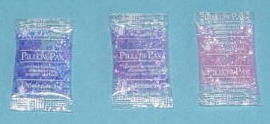
But in typical use in order to obtain the best results the user has to develop a disciple, a schedule so to speak of periodically recharging the desiccant by drying the substance in an oven. The frequency of this recharging depends on many variables but to make things easier one half of the desiccant packs that we provide include an indicating agent so that when the pack has reached its full capacity to absorb humidity it changes color. We recommend you periodically check your indicating desiccant and develop your own timetable for recharging.
Right: our indicating desiccant packets gradually change color as they absorb moisture from blue to purple, then to pink and clear.
How Much Desiccant? Desiccant is usually sold rated by performance because various substances absorb water at differing rates and vary in quantity absorbed, so the "Unit" is a standard performance based definition. One unit of desiccant is defined as the quantity having an adsorption capacity of 6 grams of water at 77° F (25 °C), at 40% Relative Humidity. The desiccant Silica Gel (SG) for example is rated at 26 grams per unit, the man made desiccant Molecular Sieve (MS) is rated 32 grams per unit, while natural clay desiccants are rated 33 grams per unit. To better understand how desiccant performance varies with type and how area affects quantity consider the table of recommendations for the telescopes below:
| Astro-Physics 105mm f/6 Traveler | Astro-Physics 160mm f/7.5 EDF | Celestron 8 | Celestron 14 | ||||
|---|---|---|---|---|---|---|---|
| Approx. Optical Tube Volume: | 208 cu in / 3,408 cu cm | 1,224 cu in / 20,058 cu cm | 930 cu in / 20,058 cu cm | 5,290 cu in / 86,688 cu cm | |||
| Recommended Clay Desiccant | 1/6th Unit or 5.5 grams | 1 Unit or 33 grams | 1 Unit or 33 grams | 4 Units or 132 grams | |||
| Recommended MS Desiccant | 1/6th Unit or 5.33 grams | 1 Unit or 32 grams | 1 Unit or 32 grams | 4 Units or 128 grams | |||
| Recommended Silica Desiccant | 1/6th Unit or 4.33 grams | 1 Unit or 26 grams | 1 Unit or 26 grams | 4 Units or 104 grams | |||
-
The above table provides useful guidelines, though not an exact desiccant recommendation for all cases since there are other factors to consider:
-
1. How closed is the telescope optical tube when the lens cover and rear DDCAP are in place?
2. Is the telescope left on open display or in a container? If in a container how well sealed is this and how much moisture can be absorbed into it?
3. What is the endurance desired before the desiccant must be replaced or recharged?
4. Is the product packed within a plastic bag within the case or packaging?
5. What are the approximate environmental conditions (temperature and relative humidity) during the period for which you need protection?
The 1.25 inch diameter DDCAP has a capacity to hold approximately 3 grams of desiccant, while the 2 inch diameter DDCAP contains approximately 6 grams. So one can see these will have some beneficial effects, especially when used with an instrument that is packaged in a container or well sealed crate (including Company Seven's own ATA Cases), or kept in an arid climate. However, one should not consider these to be a sole long-term solution for telescopes left in observatories or on display in an home open to humid climates since some air exchange will usually occur between the inside of the tube and the outside around the lens cell or focuser.
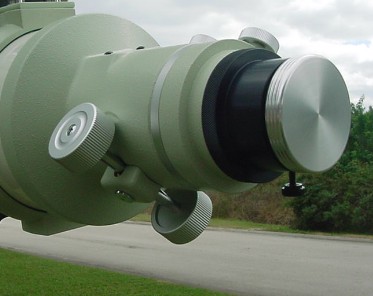
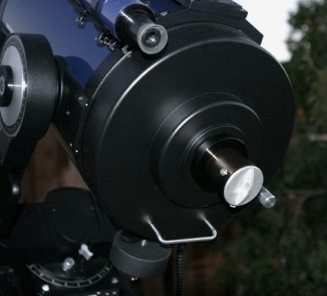
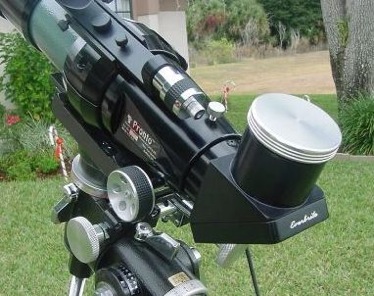
|
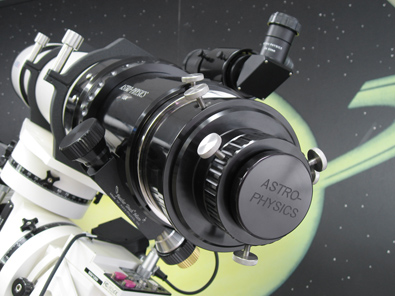
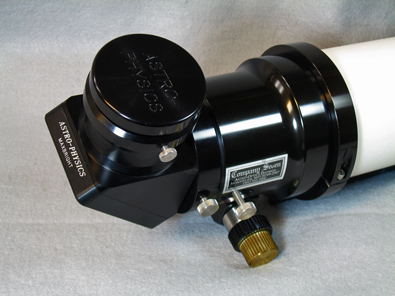
Flat DDCAPs: top row on Takahashi FS128 5 inch Apo, finger grip model on Meade LX-200, flat DDCAP on TeleVue 70mm Pronto telescopes (each image Appx. 30k bytes). |
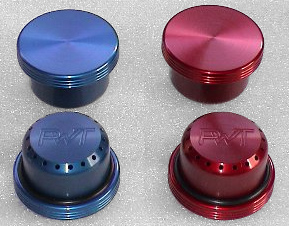 DDCAP Choices: Size, Top, Color, Engraving
DDCAP Choices: Size, Top, Color, Engraving
-
The model designation prefix will be either DDC1 for the 1.25 diameter model, or DDC2 for 2 inch versions. The 2 inch model reservoir has twice the desiccant capacity of the 1.25 inch model, so we recommend any telescope with a 2 inch or larger focuser use the DDC2 removing the 2 to 1.25 inch reducer of the telescope if so equipped.
The DDCAP is made with flat (h) or finger grip (f) covers. Either is easy to grip with or without gloves, so this choice is a matter of personal preference. However, for use on telescopes that are likely to be shipped or transported with possibilities of rough handling in transit Company Seven recommends the flat top (h) models to reduce risk of the finger grip punching through the case.
DDCAP are anodized in any one of several colors including clear (coated natural aluminum), bronze, blue, red, black.
A black 2 inch diameter flat top model engraved "ASTRO-PHYSICS" is available through Company Seven. This is designated by its Astro-Physics part number as P/N PWDDC2. This too is manufactured by PWTEC.
|
DDCAP MODELS: each include 6 refills (6 MS desiccant and 6 indicator packs)
DDC1f B, C, R or B 1.25" - flat top model DDC1fbSS DDCAP 1.25" Brass flat top model
DDC2f B, C, R or B 2" - flat top model
DESICCANT REFILL PACKETS DRC1 Recharge kit for 1.25" (20 pair of 1 gram indicating silica gel, and 1 gram MS) DRC2 Recharge kit for 2" (20 pair of 3 gram indicating silica gel, and 3 gram MS) |
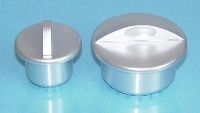
|
Contents Copyright 1994-2009 Company Seven All Rights Reserved
